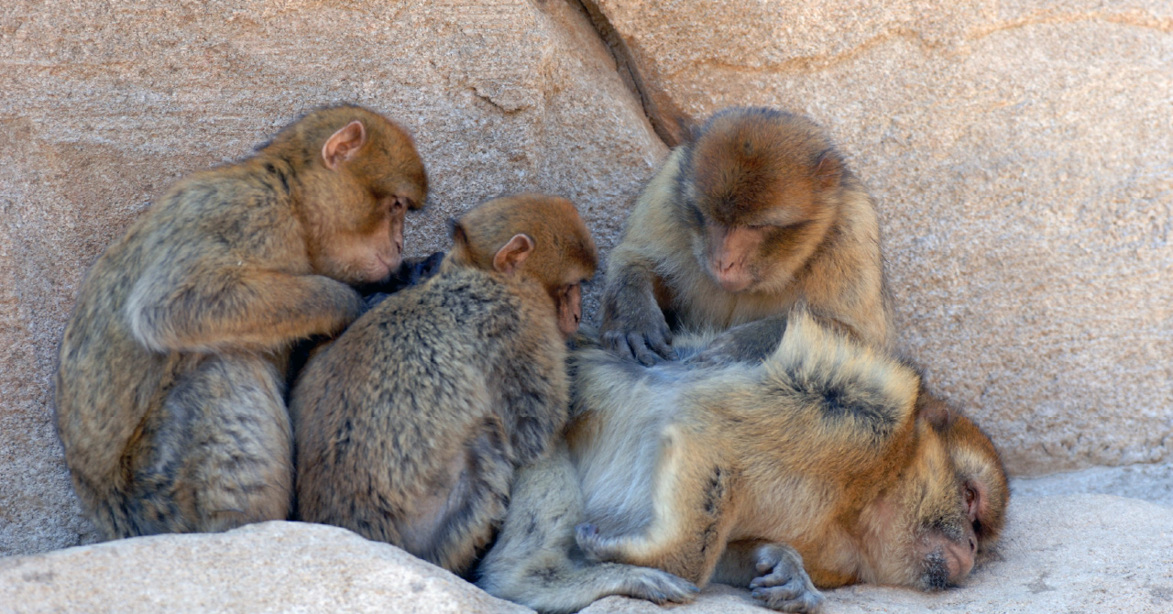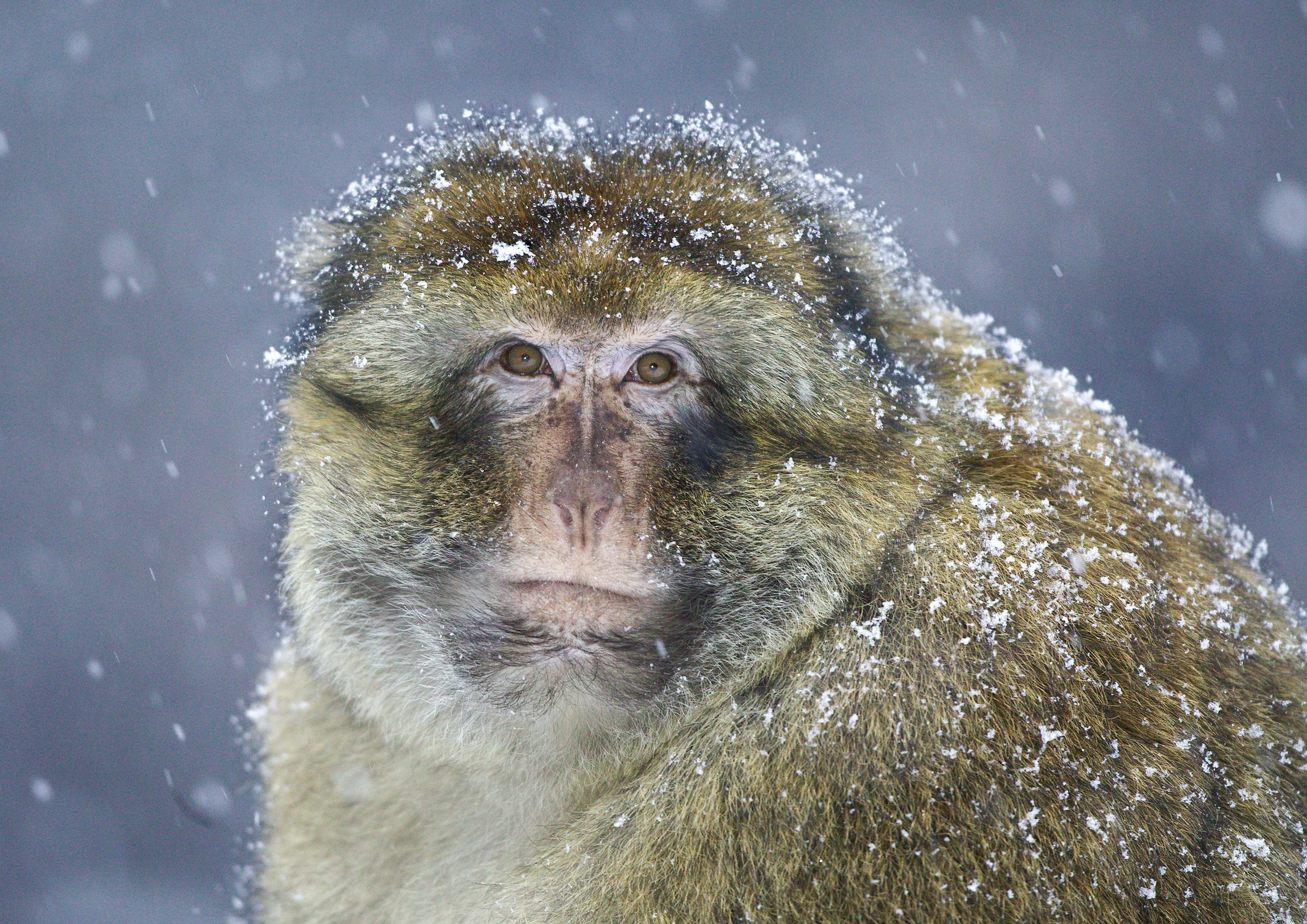Barbary macaque
Macaca sylvanus
Habitat
Coniferous forests and mountain areas
Food
Fruits, leaves and insects
Weight
♂ ± 15 kg | ♀ ± 10 kg
Age
20 to 25 years
IUCN Status
Bedreigd
Appearance
Barbary macaques have thick, brown-yellow fur, which protects them against rain and cold weather. Males and females may look alike, but males are often slightly larger in size. Fun fact: Barbary macaques do not have a visible tail. They only have a small stump that is hidden by their fur. Barbary macaques have cheek pouches and use these to store food, so they can eat this at a later time. Did you know these cheek pouches can hold an equal amount of food as their stomach?!
Habitat
In the wild, Barbary macaques live in coniferous forests at the Middle and High Atlas- and Rif, Grande and Petite Kabylie Mountains on the border between Morocco and Algeria. Differences in temperatures between summer and winter can be quite extreme, with hot and dry weather in summer and freezing temperatures during winter time. Do not be surprised when you see a Barbary macaque in the snow!
Social organisation
Barbary macaques live in large groups of 25 animals on average. In the group, animals live according to a strict hierarchy, where each animal knows its position within the social structure. This way, stability and peace can be ensured. Some animals have a high-ranking position, and others are more subordinate. Infants ‘inherit’ the social status of their mothers, so female infants born from high-ranking individuals often become high-ranking themselves. Adult male Barbary macaques need to acquire their own position when they emigrate to another group.
Behaviour
Barbary macaques use vocalisations and facial expressions to communicate with each other. During conflicts or when threatening each other, they may hit the ground, stare at each other or show their teeth. Possibly, you may also observe some Barbary macaques smacking their lips. Depending on how they do this, lip smacking towards another animal is their way of saying “you are the dominant one”. Barbary macaques often groom each other, and not only for hygienic reasons. Grooming one another is important to maintain social bonds, and can even be used as a commodity!

Reproduction
Barbary macaques have a mating- and birthing season. Infants are born with thin, dark fur. Only after a couple of months, their fur changes to light-brown to match the adult coat colouration. You can recognise recently-born infants by their wrinkly faces and (apparently) huge ears. A tiny tail may still be visible, but will quickly ‘disappear’ and be covered underneath their fur once they grow older. New born infants are first carried on the belly of the mother, but after a couple of weeks, they ‘move’ to their mom’s backside to hitch a ride. Infants are weaned after approximately one year; this means they are no longer allowed to nurse at their mother.
Barbary macaques are known for their alloparental care, which means other individuals in the group take part in the care of the infants; this is done by both adult males and females. Infants actually receive quite some attention from other group members, and many group members like to spend time or carry the infants. That may be because carrying an infant means you are allowed to do things you normally cannot do, such as spending time near individuals high in rank. Males may leave the group they are born in at the age of three to four years to join another Barbary macaque group. Often, females stay in their natal group their whole life. They become sexually mature at the age of four and will then give birth to their own offspring.
Situation in the wild
The species of Barbary macaques used to exist in large areas in Northern Africa and parts of Europe. Unfortunately, considerable parts of their habitat have disappeared over the years, because of extensive logging and habitat destruction. Besides this, illegal trade in Barbary macaques for tourism and the pet industry caused populations to decline as well. That is why, nowadays, Barbary macaques can only be found in small, fragmented forest areas in the mountain regions in Morocco and Algeria.

At Apenheul
Population management programme
Fun facts
- Like other macaques, Barbary macaques have callused patches on their rear, called sitting pads. For this reason, macaques have the ability to sleep sitting upright, for example on tree branches.
- Barbary macaques are the only African primates that live north of the Sahara.
- Barbary macaques are one of the few primate species that develop a winter coat. This coat thickens during the fall season and is lost again in spring.
- Next to the mother, the male Barbary macaque leader of the group may carry his new born offspring as well. The alpha male is actively involved in protecting both the mother and the infant.
Want to see the barbary macaques at Apenheul?
Get your tickets now and roam freely among the primates!

Welcome to Apenheul
Open for business events
Park open from Friday 20 March, 10.00 hour